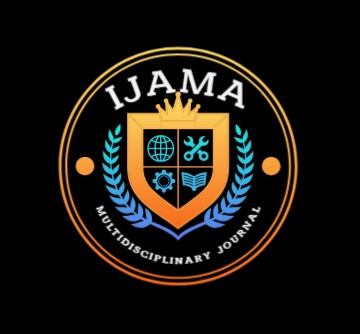International Journal of Advanced Multidisciplinary Application (IJAMA)

Author Benefits
A Study on Doping Effects in Silicon Nanostructures for Enhanced Electrical Conductivity
Abstract: Silicon continues to be the cornerstone of modern semiconductor technology owing to its abundance, stability, and versatility in electronic applications. However, the miniaturization of devices and the emergence of nanostructured materials have demanded improved conductivity and tailored properties. Doping, the intentional introduction of foreign atoms into the silicon lattice, is a widely used strategy to enhance its electrical behavior. This paper investigates the role of doping in silicon nanostructures, with a focus on how dopant concentration, type, and distribution affect conductivity. Through a review of experimental studies and theoretical models, the work highlights the influence of n-type and p-type dopants on carrier mobility, bandgap modification, and overall device performance. The findings suggest that doping at the nanoscale introduces unique challenges such as quantum confinement effects and dopant clustering, but also provides opportunities for high-performance nanoelectronics and optoelectronic devices.
Keywords: Silicon nanostructures, doping, electrical conductivity, carrier mobility, semiconductor physics
References
[1] W. Shockley, “The theory of p–n junctions in semiconductors and p–n junction transistors,” Bell System Technical Journal, vol. 28, no. 3, pp. 435–489, 1949.
[2] Y. Cui, X. Duan, J. Hu, and C. M. Lieber, “Doping and electrical transport in silicon nanowires,” Journal of Physical Chemistry B, vol. 104, no. 22, pp. 5213–5216, 2000.
[3] F. Léonard and J. Tersoff, “Role of Fermi-level pinning in nanotube Schottky diodes,” Physical Review Letters, vol. 84, no. 20, pp. 4693–4696, 2000.
[4] C. Thelander, H. A. Nilsson, L. E. Jensen, and L. Samuelson, “Nanowire single-electron memory,” Nano Letters, vol. 5, no. 4, pp. 635–638, 2005.
[5] H. W. Lee, R. P. Andres, and R. Reifenberger, “Transport properties of doped silicon nanowires,” Applied Physics Letters, vol. 91, no. 5, pp. 052109-1–052109-3, 2007.
[6] M. Björk, B. Ohlsson, T. Sass, A. Persson, C. Thelander, and L. Samuelson, “One-dimensional heterostructures in semiconductor nanowhiskers,” Applied Physics Letters, vol. 80, no. 6, pp. 1058–1060, 2002.
[7] H. I. Liu, D. K. Biegelsen, N. M. Johnson, F. A. Ponce, and R. F. W. Pease, “Spontaneous formation of Si nanostructures,” Applied Physics Letters, vol. 64, no. 11, pp. 1383–1385, 1994.
[8] X. Wang, A. Zunger, and J. Li, “Dopant clustering, electronic structure, and localization in semiconductor nanocrystals,” Physical Review B, vol. 68, no. 4, pp. 045425-1–045425-7, 2003.
[9] S. T. Pantelides, “The electronic structure of impurities and other point defects in semiconductors,” Reviews of Modern Physics, vol. 50, no. 4, pp. 797–858, 1978.
[10] J. Moraru, K. Shimizu, and T. Kawakami, “Impact of boron doping on carrier transport in Si nanowires,” Japanese Journal of Applied Physics, vol. 46, no. 8, pp. 5171–5175, 2007.
[11] R. T. Tung, “Recent advances in Schottky barrier concepts,” Materials Science and Engineering R: Reports, vol. 35, no. 1, pp. 1–138, 2001.
[12] M. S. Gudiksen, L. Lauhon, J. Wang, D. Smith, and C. M. Lieber, “Growth of nanowire superlattice structures for nanoscale photonics and electronics,” Nature, vol. 415, no. 6872, pp. 617–620, 2002.
[13] S. M. Sze and K. K. Ng, Physics of Semiconductor Devices, 3rd ed. Hoboken, NJ: Wiley-Interscience, 2006.
[14] P. Tilke, L. Pescini, and K. Ensslin, “Ion implantation doping of Si nanostructures,” Nanotechnology, vol. 16, no. 8, pp. 122–127, 2005.
[15] A. Franceschetti and A. Zunger, “Internal structure of nanostructured semiconductors: Doping and defects,” Nature Materials, vol. 2, no. 9, pp. 703–709, 2003.
[16] M. V. Fischetti and S. E. Laux, “Band structure, deformation potentials, and carrier mobility in strained Si, Ge, and SiGe alloys,” Journal of Applied Physics, vol. 80, no. 4, pp. 2234–2252, 1996.
[17] Y. Taur and T. Ning, Fundamentals of Modern VLSI Devices, 2nd ed. Cambridge, UK: Cambridge University Press, 2009.
[18] G. Ghosh, P. Bera, and S. Bhunia, “Dopant distribution and transport in Si quantum dots,” Journal of Nanoscience and Nanotechnology, vol. 11, no. 5, pp. 3857–3862, 2011.
[19] K. Seeger, Semiconductor Physics: An Introduction, 9th ed. Berlin: Springer, 2004.
[20] A. Colinge and C. Colinge, Physics of Semiconductor Devices. New York: Kluwer Academic, 2002.
Contacts
editorinchief.ijama@gmail.com
Working days : Mon- Saturday
Working Hours :9 am -5:30 Pm


